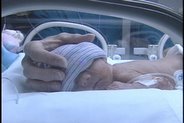The Association for Professionals in Infections Control (APIC), has just released a comprehensive study that found MRSA rates may be much higher than earlier thought. Results showed that MRSA infection and/or colonization rates are at least 8 times greater than the results of previous studies. You can find the study on APIC’s web site here.
The study is significant because it surveyed a broader spectrum of hospitals and patients than any earlier study. So now that you know the prevalence of MRSA, what to do about it? APIC has some direction there as well. Health care workers can download the Guide to the Elimination of Methicillin-Resistant Staphylococcus aureus (MRSA) Transmission in Hospital Settings. This resource is another good start, although it only devotes 2 pages to environmental transmission of MRSA. A quick check of the text finds 62 mentions of the word ‘contact’, as in ‘contact transmission’. There are zero mentions of the term ‘airborne’, as in ‘airborne transmission’.
Why the omission? Could it be that there is no science to back-up the assertion that MRSA is spread via the air? Perhaps these studies were overlooked:
Significance of Airborne Transmission of Methicillin-Resistant Staphylococcus aureus in an Otolaryngology–Head and Neck Surgery Unit1
In this 2001 study, Japanese doctors attempted to measure if MRSA could be found in the air of a surgical hospital ward. The rooms of three patients who acquired MRSA after surgery were monitored with air samplers and surface swabbing.
Results:
MRSA was detected in all three rooms in the air and on surfaces. 20% of the MRSA particles were within the respirable range, of less than 4 µm.
From the study:“Methicillin-resistant S aureus was recirculated among the patients, the air, and the inamimate environments, especially when there was movement in the rooms. Airborne MRSA may play a role in MRSA colonization in the nasal cavity or in respiratory tract MRSA infections. Measures should be taken to prevent the spread of airborne MRSA to control nosocomial MRSA infection in hospitals.”
Reduction in MRSA environmental contamination with a portable HEPA-filtration unit.2
In 2006 microbiology researchers in the
Results:
95% of settle plates placed in the wards showed MRSA contamination. Plates were placed in a variety of locations, mostly along the perimeter of the room. When HEPA filtration was introduced, measurable MRSA decreased between 73%-95%. This study makes a direct link between air and the dispersion of viable MRSA.
From the study:“Although this cannot replace standard infection control measures (e.g. isolation, hand hygiene, protective clothing and cleaning), it is likely to reduce cross-infection risks significantly and could provide a relatively cost effective method for enhancing MRSA control.”
In 2005 Turkish researchers used more than 900 data points to measure airborne pathogens and the colonization of those pathogens in hospital patients. The study tracked 179 patients and found that MRSA is definitely airborne.
Results:
Researchers proved that MRSA was airborne through the use of air samplers. The two most common airborne pathogens were MRSA and Acinetobacter baumannii. Furthermore, the study says there is a link between the concentration of these airborne pathogens and colonization in patients.
From the study: “It can be concluded that, total number of airborne viable particles in the critical areas such as operating theatres and intensive care units, seems to be a significant risk factor for the development of nosocomial infections in immuno-compromised patients.”
A deadly outbreak of S. marcescens vexed the staff members of a NICU located in the United Arab Emirates (UAE). In total 36 infants were infected, leading to the death of five babies. Concerned healthcare workers desperately worked to find the source of the outbreak.
Results:
Researchers determined that the reservoir of the deadly pathogen was the air conditioning system that fed the NICU. Despite many typical infection control interventions such as staff education, environmental cultures, isolation of colonized patients, compliance with aggressive infection control measures and recognition of the role of cross contamination the colonization of infants grew. When environmental sampling suggested that contamination was emanating from the air conditioning system, the hospital thoroughly sanitized the system. After this measure the 20 week outbreak ended.
From the study:
“…the growth of serratia from airflow samples suggested that the primary source of
this outbreak was the AC duct.”
“In conclusion, we have documented in this report the results of extensive surveillance and the importance of the AC duct site as a reservoir of nosocomial pathogens in the SCBU of a community hospital. The possibility of airborne transmission in nosocomial spread should not be underestimated.”
Although there is ample evidence that MRSA and other pathogens are transmitted via the air, most infection control measures focus on contact precautions. Data indicate that contact transmission predominates, so the emphasis on contact precautions is warranted.
It is reasonable, however, to also address other environmental contributors to infection. As we’ve learned recently in reducing VAP, a bundling approach yielded impressive infection rate reductions. Bundling recognizes that infection control is multifaceted and requires new thinking and new strategies. Bundling’s success proves that infection control is achieved through a system of evidence based measures.
Instead of thinking about infection control as breaking a single link in the ‘chain of transmission’, consider infection as a web with many avenues of opportunity. One of those avenues, the airborne route, deserves greater attention.
References
1. Significance of Airborne Transmission of Methicillin-Resistant Staphylococcus aureus in an Otolaryngology–Head and Neck Surgery Unit
Teruo Shiomori, MD, PhD; Hiroshi Miyamoto, MD, PhD; Kazumi Makishima, MD, PhD
Arch Otolaryngol Head Neck Surg. 2001;127:644-648.
2. Reduction in MRSA environmental contamination with a portable HEPA-filtration unit
TC Boswell; PC Fox
Journal of Hospital Infection 2006 May;63(1):47-54
3. The relationship between airborne colonization and nosocomial infections in the intensive care unit
G Dürmaz, et al
Mikrobiyol Bul. October 2005 (article in Turkish)
4. An outbreak of Serratia marcescens infection in a special-care baby unit of a community hospital in
S. A. Uduman, et al
Journal of Hospital Infection (2002) 52: 175±180

